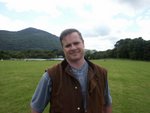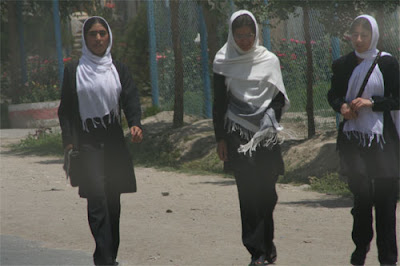 The sun is well overhead, but you would not know it by this picture.
The sun is well overhead, but you would not know it by this picture.The trees almost intertwine over this road.
In places such as this in Kabul where there are one-way streets,
a tree-filled park often fills the space between the roadways.
A couple people have commented on how dry things look here. And yes, especially this time of year, there is not much rain. It spits on occasion – usually in the evening. Most of the precipitation that falls comes in the form of snow…lots of snow…during the winter months. There are, however, well-stocked aquifers below the surface. The problem is getting it to the surface in quantities useful for agriculture. The Afghans once had that problem fixed, but first the Mongols (back in the 1200's) and then the Soviets wrecked the irrigation systems.

A broad one-way avenue with a park to the left and vendor's stalls placed beneath the trees on the right. Note the wet pavement on the right. Kabul residents tend to be a bit free with water since they have it in abundance. Even with the city six times larger than before the wars, there is no shortage of water.

A closeup of the jungle, I mean park, just off the roadway.
Villages tend to be built where the water is closer to the surface and therefore easier to extract. Kabul has existed for perhaps 3,000 – 5,000 years. The city is near the base of the Hindu Kush next to the Kabul River, which during summer months is little more than a stream. The city benefits from the spring snow melt, but much of the water disappears below the surface long before it reaches Kabul. However, that water still reaches Kabul because the city sits on top of a very large aquifer. The aquifer is so close to the surface that trees – large trees – thrive here.

This median is filled with trees, though some of the older ones in this picture bear the scars of war. The median is at best six feet wide. If it is possible to grow a tree at all in a particular patch of soil, the Kabul residents will plant one there and nurture it.
Kabul once had many more trees, but the Soviets cut down most for security reasons (the mujahadeen hid in them to snipe at the Soviets). After the Soviets left and the warlords fell to fighting one another, the city was shelled for almost three straight years from 1993 to 1996, destorying or damaging more trees. Then when the Taliban was in power, they paid little attention to planting new trees. Since the Taliban’s fall, trees are being planted at a dizzying pace.

Another tree-filled neighborhood.
Most of my earlier pictures haven’t shown lots of trees, or they were of the smallish variety. So today I’m putting up pictures of tree-lined streets and parks. Afghans love their trees, but Kabul residents take that love to a different level. They are exceedingly proud of their trees – rather like proud parents. The fact that the Soviets cut down so many trees almost angers the locals more than all the other damage.

The overall effect of so many trees is that Kabul is cooler than it
may have been otherwise regardless of altitude.













